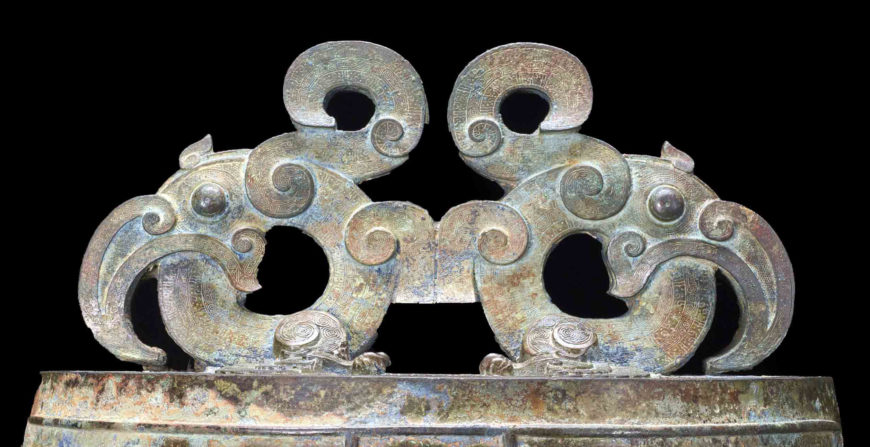
Bell (bo) with birds and dragons; from a set of four, late Spring and Autumn period, Eastern Zhou dynasty, ca. 500–450 BCE, bronze, China, Shanxi province, State of Jin, Houma foundry, 66.4 high x 47 cm (Freer Gallery of Art, Smithsonian Institution, Washington, DC: Purchase — Charles Lang Freer Endowment, F1941.9)
This type of Chinese bronze bell is called a bo. Different from western bells, it’s not meant to be swung back and forth to make a sound. Instead, you hit it on the outside with a wooden mallet. Almond-shaped if you looked at it from below, it produces two tones depending on whether you strike it near the center or the edge. The bo would have been hung from the loop on top.

Bell (bo) with birds and dragons; from a set of four, late Spring and Autumn period, Eastern Zhou dynasty, c. 500–450 B.C.E., bronze, China, Shanxi province, State of Jin, Houma foundry, 66.4 high x 47 cm (Freer Gallery of Art, Smithsonian Institution, Washington, DC: Purchase — Charles Lang Freer Endowment, F1941.9)
The loop is formed by a decoration that looks like a pair of birds. Their bodies face each other while their heads turn back to swallow their cat-like tails.

Bell (bo) with birds and dragons; from a set of four, late Spring and Autumn period, Eastern Zhou dynasty, c. 500–450 B.C.E., bronze, China, Shanxi province, State of Jin, Houma foundry, 66.4 high x 47 cm (Freer Gallery of Art, Smithsonian Institution, Washington, DC: Purchase — Charles Lang Freer Endowment, F1941.9)

Bell (bo) with birds and dragons, late Spring and Autumn period, Eastern Zhou dynasty, c. 500–450 B.C.E.
On either side of the bell are eighteen round knobs or bumps. We don’t know if these knobs are purely decorative or had a musical or acoustic function. If you look closely, you will see a small head in the middle of each bump. They are coiled snakes. Low relief dragons cover the bottom of the bell and horizontally divides the three bands of bumps.
Although made in different sizes, bo are usually quite large in order to generate deep bass notes. Weighing almost 140 pounds, this bell is the largest of a set of four. Together the set could produce eight different notes. Sets of bells were an important aspect of Zhou bronze production. During the Eastern Zhou period (c. 770–256 B.C.E.), central Zhou authority became increasingly weakened. Meanwhile, regional courts began fighting each other not only for land and political control but also for cultural supremacy. Music was a key part in this display of superiority. In fact, casting a perfectly tuned set of bells was thought to signal good government and a proper relationship with heaven.
Making a large bronze bell like this one was a costly commission in terms of both material and labor. Its elaborate decoration further emphasizes the high status of bronze bells as a luxury restricted to rulers and the elite. Besides its political implications, owning a set of bells was also thought to bring great happiness to a family. Cherishing their bell sets, many owners chose to be buried with them. The greenish coating (patina) on this bell is result of having been buried; the owner wanted to hear its beautiful sound in the afterlife.
This resource was developed for Teaching China with the Smithsonian, made possible by the generous support of the Freeman Foundation


